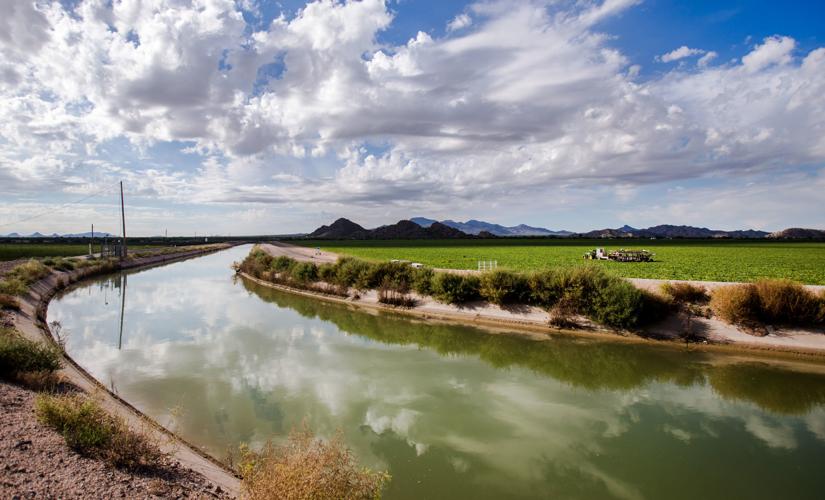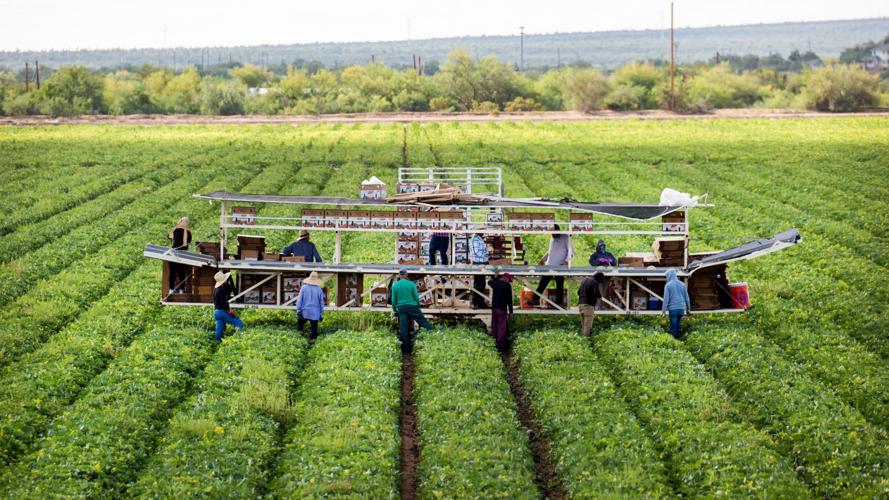PHOENIX — A new plan to deal with less Colorado River water being available for Arizona would give Pinal County farmers the same amount of water as previous plans — but much of it as groundwater.
It would be a return to historic form for many Pinal farmers, who significantly cut their groundwater pumping in the 1980s when they first started taking Central Arizona Project canal water from the Colorado River.
The plan also would find new ways to provide backup, “mitigation” water for farms and other water users without taking it from Lake Mead — where water has been deliberately left to raise the lake’s elevation.
Those two ideas were centerpieces of a new Drought Contingency Plan, presented by the Arizona Department of Water Resources Thursday at a meeting of an advisory committee. The committee represents many key water interest groups — cities, farms, developers, tribes and ranchers.
This plan modifies another plan, recommended on Nov. 15 by the governing board for the CAP, which delivers Colorado River water to Tucson, Phoenix, Pinal County farmers and several Indian tribes.
The new plan would cost more than $100 million to find replacement water for farmers, tribes and others affected by cuts in CAP deliveries and to compensate users who lose their water.
CAP General Manager Ted Cooke and Arizona Water Resources Director Tom Buschatzke agreed Thursday that this proposal brings Arizona a step closer to a finished plan, ready for approval next year by the Legislature.
But with farmers and developers raising concerns about this proposal, they said the committee will need numerous additional meetings before approving a final plan. That raises questions as to whether a plan can be approved by the end of 2018, as the federal government has insisted on.
“Closeness is in eyes of the beholder. In the eye of this beholder, I think we are very close,” Cooke said in a media briefing held after the four-hour meeting. “There are a finite number of remaining issues to sort out. There’s lots of work to do on detail.”
Seeing “a light at the end of the tunnel,” Cooke said he’s prepared to recommend something very close to this plan to CAP’s 15-member elected governing board. Some elements still need clarifying, said Cooke, who declined to elaborate.
The plan got a big boost Thursday when Gov. Doug Ducey committed to recommending $30 million in his proposed fiscal 2019-20 state budget to pay various water users not to take some of the river water they have rights to. That idea would leave the unused water in Lake Mead.
Ducey has made this plan a top priority, as a way of showing the state “has its act together” on water issues so as to encourage continued economic development.
Buschatzke said he was very encouraged by the comments about the plan from participants at the meeting.
“We’re getting close to having a deal,” he said. “This is about our future. This is about being proactive and about finding collaborative solutions.”
The CAP has agreed to kick in $60 million for this plan, while state officials hope to lure $30 million in federal money and another $8 million from the Walton Family Foundation and other environmental groups.
Developers, farmers still have concerns
But the political divide over this plan is a mirror image of the split over the plan recommended by the CAP board two weeks ago. City and tribal officials who were wary of CAP’s proposal supported the new plan, while farmers and developers who supported the earlier plan were critical of this one.
The drought plan is aimed at leaving enough river water in Lake Mead to keep it from rapidly falling to levels where it would be impossible to extract any water.
The lake has dropped by more than half since 2000, due to climate change, overuse and drought. The Bureau of Reclamation has said that at the rate it’s falling, there’s a 40 percent chance Mead will drop below 1,025 feet between 2024 and 2026 without a drought plan. At that level, the federal government might take over management of the river. Cities such as Tucson with high-priority rights to CAP water could lose some of their supplies.
As the plan is conceived, Arizona would lose about 500,000 acre-feet of water — roughly one-third of CAP’s annual supply — when Mead drops below 1,075 feet at the end of a year and the feds declare the first shortage. A 57 percent chance exists of that happening by 2020, the reclamation agency has said. At 1,025 feet, the CAP would lose nearly half its supply.
Until now, a big point of conflict was farmers’ insistence on “full mitigation” of planned CAP cuts. Cities and tribes took exception to earlier Drought Contingency Plan proposals, because they called for the release of 400,000 acre-feet of water from Mead that Arizona had previously left there to prop it up.
The new proposal would still give the farmers water they say they need — 538,000 to 621,000 acre-feet over seven years starting in 2020. But they would get river water only through 2022. Then they’d have to rely on pumping, and would get at least $30 million federal financing to help them drill new wells and install other infrastructure.
The farms had already expected to lose all their CAP water by 2030 under a 2004 Indian water-rights settlement. This would get them back on groundwater much sooner.
The plan also details ways of getting 400,000 acre-feet of water from other sources to compensate for the water taken out of Mead to help farms and other users get mitigation water.
Paul Orme, lobbyist for four irrigation districts, said their biggest concern is that this plan contains no clearly identified, assured federal source to pay for new wells. Most likely, they’d have to rely on several federal programs, including the omnibus farm bill approved periodically by Congress, to get the money.
“We’ll have no certainty that that piece will be available by January 2019, when presumably the vote on DCP has to take place. This just can’t be a hope and a prayer,” said Orme.
Representatives of homebuilders associations from Southern and Central Arizona criticized the plan because unlike the CAP proposal, this one doesn’t contain any “mitigation water” for developers.
Until now, the three-county water district that runs the CAP has set aside river water each year for replenishing aquifers that are pumped out for new development, but this plan wouldn’t do that.
Advisory committee member Rep. Rusty Bowers, who is about to become state House speaker, also raised concerns about the plan.
Tribe, cities like IT
Acknowledging that the plan isn’t perfect, Gila River Indian Community Gov. Stephen Ray Lewis said it’s “the only viable plan we can see.” While the tribes would lose some of their CAP water without mitigation in this plan, “It addresses our third rail,” because it doesn’t remove more water from the lake without finding other sources to put it back in. He also pledged to support federal financing for well infrastructure for Pinal farmers.
“All we have asked is to be treated fairly and equitably,” Lewis said.
Officials from Tucson, the Metro Water District northwest of Tucson, Phoenix and Scottsdale water agencies backed this plan.
Tucson Water Director Tim Thomure said the proposal would offset the loss of Lake Mead water, provide federal money to help the farmers and would not raise water rates to residents more than already expected because river shortages will naturally raise prices due to supply and demand.
“A deal that every single user can find something to hate is a deal that works,” said Cynthia Campbell, water resources administrator for the city of Phoenix.





